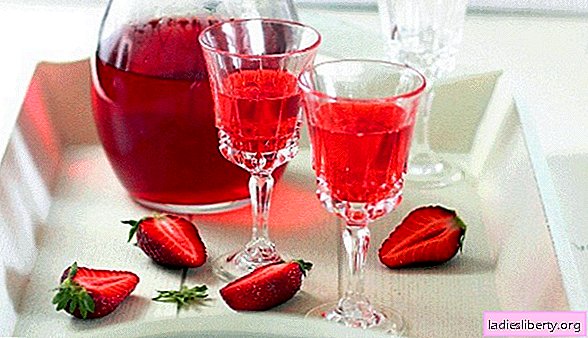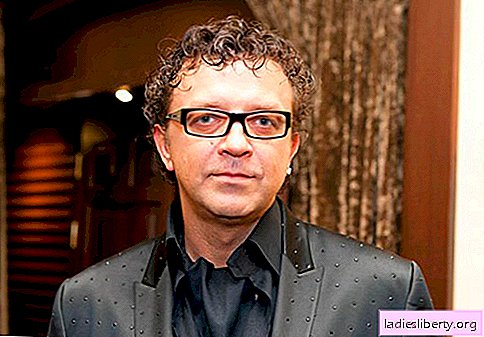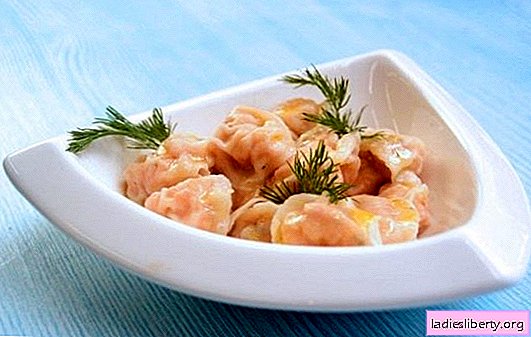
The refined aroma of wild strawberries has gained popularity in world culinary and formed the basis of many dessert dishes, and for home winemakers these berries are a wonderful wine material. It produces a beautiful and fragrant young wine of pale pink color, and home-made mature wines from strawberries acquire an amber color over time, without losing their characteristic bouquet.
Wine from wild strawberry - the basic technological principles
For any winemaking, both industrial and home, grape and fruit, there are general rules that must be followed when making wine.
The standard of biochemical composition for the production of wine is grapes, as the oldest wine material on the planet. It is on the basis of a biochemical analysis of grape berries that the optimal composition of wine must is revealed - fruit juice with the addition of sugar, wine yeast and some other components for producing wine.
It cannot be argued that fruit and berry winemaking is a new area of oenology. It is possible that fruit and berry wines appeared along with grape wines, but some additional efforts are necessary for their preparation, because, in addition to apples, all other fruits differ from grapes either by a deficiency or an excess of acids, which add stability to the wine. In strawberries, both garden and forest, the percentage of sugar and acid is ideal for home winemaking. True, there are some nuances that must be taken into account when making strawberry wine.
Before preparing the wort, the juice of the fruit and berry crops is examined for the presence and percentage of acids, including tannic, tartaric acid, in order to regulate it before setting the wort.
For normal fermentation of the wort, the acidity of the wine material is not lower than 0.7% per liter of wort. Too low acidity does not add taste to the wine, makes it unstable - this wine is susceptible to disease and quickly deteriorates. Acidity above 1.0% is fraught with infection of the wort with vinegar yeast. Strawberry juice per unit volume contains an average of 0.8%, which corresponds to the standard.
Of course, it must be borne in mind that depending on weather conditions and some other natural factors, this figure may vary. Forest strawberries are more acidic than garden strawberries. It may contain acids up to 1.2%. In these cases, acidity is reduced by adding water or blending strawberry juice with juices of less acidic fruits or berries.
Mixing strawberry juice is also recommended to increase the volume. Due to the dense structure of berries of wild strawberries, the juice contains less juice than in the garden. For maximum extraction, the method of preliminary fermentation of pulp or juice with subsequent pressing is used.
In fact, forest strawberries can simply be chopped by combining its pulp, for example, with a pulp of strawberries, raspberries, adding sugar syrup and in this form put for fermentation. When water is added to the wort, the finished wine is less saturated, as its presence is felt in it. Therefore, water is often used to prepare dry table wines, and to obtain strong, dessert and liquor tend to use only natural raw materials, without dilution.
The next important criterion for assessing the quality of the wort is sugar content. As you know, the strength of any alcoholic beverage depends on the sugar content. More sugar - more alcohol. But for wine, sugar is not only a fortress, but also a taste. With an average sugar content of wild strawberries of 7.8%, this amount of sugar is clearly not enough to get even a light table wine.
Practical advice is: to get the desired strength to the natural sugar content in a liter of wine material (in this case, wild strawberries) add 20 g of sugar per 1% of the strength.
For example:
The sugar content in 1 liter of wild strawberry juice is 6%. The desired wine strength is 12%. You need to add 120 g of sugar per liter of wort. At the same time, an additional 3% sugar must be added to the indicated amount to form a taste. This is an example for making dry, low-degree wine. The amount of added sugar varies depending on the type of wine, the required strength and sugar content.
Please note that excess sugar in the wort is harmful to yeast.
Now about yeast, microorganisms that process sugar, turning it into alcohol. But sugar alone is not enough for yeast. The main condition for a successful fermentation process is a constant temperature of 18-22 degrees, which is considered the most comfortable for the normal performance of wine yeast.
Light wines from strawberries can be prepared without the use of yeast and wine yeast, but strong drinks cannot be obtained without using pure cultures.
Many fruits and berries used in home winemaking require prior preparation, which consists of cleaning, removing seeds and chopping. In this regard, strawberries do not require preparation. In addition, its fruits are often used to make wine starter, because wild strawberries are an ideal habitat for wild wine yeast.
Strawberry aroma is often used to improve the quality of other fruit wines, so strawberries are added, both for making pulp and for blending juices or ready-made fruit and berry wines.
The peculiarity of strawberry wine material is that the grains contained in the berries add bitterness to the wine. Therefore, if there is no goal to create a sherry flavor, they must be removed by grinding berries through a sieve or during the pressing and separation of juice.
You do not need to wash the berries, so as not to wash off wild yeast from their surface, but it is also not worthwhile to let too contaminated berries get into the must. Sort the fruits thoroughly before starting work.
Recipe 1. Table wine from strawberries
Composition:
Wild berries 9.5 kg
Sugar 1.25 kg
Water 3.6 L
Cooking:
Boil the water and sprinkle all the sugar into it. After its dissolution, let the syrup cool down to 25 degrees and pour them with the berries chopped into the pulp, after having selected them and removing the stalks.
Cover the pot with the wort and set it to ferment in the warmth. Before the foam appears on the surface of the wort, do not forget to periodically mix it.
Pass the fermented juice through a filter and rub the pulp through a sieve to prevent small grains from entering the wort (they will add an unpleasant bitterness to the wine).
Connect both parts of the wort and pour it into the bottle. Fermentation should take up to 60 days, at a constant temperature of 18-22 degrees, which is optimal for making wine from strawberries and other wines.
After the fermentation is completely stopped and the sediment settles at the bottom of the bottle, remove the new wine from the sediment. Take it to a cool place, tightly corking. Store wine in the basement. If sediment reappears, repeat removal.
Recipe 2. Strong table strawberry wine
Composition:
Wild strawberry 10.7 kg
Water 2.4 L
Sugar 1.9 kg
Manufacturing technology:
Divide the taken amount of sugar into two parts. Sort the berries, removing the spoiled ones. Separate the sepals, but you don’t need to wash them. Grind immediately and add half the sugar dissolved in warm water. Cover and place the container for a day or more for fermentation in a warm place, so that the juice that needs to be passed through a sieve is better separated, wiping and separating small grains.
Pour the prepared wort into the bottle, filling it ¾ of the volume, close the neck with a medical glove, in which one of the fingers is punctured with a thick needle: carbon dioxide must be escaped while preventing oxygen from entering the wort.
After 10-14 days, when the rapid fermentation stops, add the rest of the sugar, close the neck again. To make the added sugar dissolve faster, pour 1.5-2 liters of wort from the bottle, pour sugar into it and mix while heating, but the heating temperature should not exceed 30 degrees, at which the wine yeast dies. Then pour the warmed and sweetened wort into the bottle.
After mixing again, put on a glove and then it remains to wait for the completion of the fermentation process. This is indicated by the precipitation at the bottom of the bottle, the absence of even the smallest gas bubbles rising to the surface. The wine is gradually clarified, becomes transparent. Pour carefully, without agitating the sediment and using a plastic tube, while installing a bottle of wine and an empty container at different levels to ensure the principle of operation of communicating vessels.
It is important not to overdo it on the lees for more than two weeks, otherwise, the remains of yeast lying at the bottom will greatly spoil the taste of bitterness. If in two weeks the wine still has not become transparent enough, still pour it into a clean, pre-prepared bottle, and then repeat this procedure again, but already resorting to the filtration method, using a fairly dense filter.
Fresh strawberry wine is ready. It has a fairly bright and characteristic aroma. Take it to a cool place by tightly closing the storage container. The taste and color of the wine will gradually change, but even in the aged wine from strawberries, a reminder of the forest berries that will complement its bouquet will remain.
Recipe 3. Strong strawberry and strawberry wine
Composition:
Sherry yeast 2 g
Wild strawberry 4 kg
Garden strawberries 10 kg
Tannin 20 g
Sugar 3.2 kg
Wine alcohol (70%) 0.7 L
Cooking method:
From the specified number of berries should be at least 8 liters of natural juice. Place the prepared berries under the press together. Forest berries have a more stable and pronounced aroma, and garden strawberries are more juicy. This is a great combination for wine if you want it to be watery. But, if less juice is obtained, then the water will have to be added, first bringing it to a boil and cooling to 22-25 degrees. Add half the sugar to the juice.
To get strong wine, wild yeast on the surface of freshly picked berries will not be enough; therefore, when acquiring cultured yeast, opt for sherry cultures: they are more stable in an alcoholized environment, which is necessary for making strong wine.
Add ½ part of sugar to the juice, mix until dissolved and pour the wort into a bottle. Close the neck with a water lock. After waiting for the stage of quiet fermentation, introduce the rest of the sugar and yeast into the must. This time the wort should completely ferment. Remove the new wine from the sediment, add tannin, alcohol and sugar, if necessary, to taste. Ideally, if the wine will be stored at 14 degrees in an oak barrel. For lack of such a container, use a glass bottle with a wide neck, inside of which, along with wine, a gauze bag with oak bark should be placed.
Strong wine will get a real bouquet in 8-10 months. Its color will become amber.
Recipe 4. Dessert wine from wild strawberries forest and garden
Composition:
Berries 13 kg
Tannic acid 14 g
Sugar 3.7 kg
Cooking:
For dessert wine from strawberries, natural juice is used, which should be about 8 liters from the prepared berries. Add sugar to the juice, leaving 510 g to sweeten and stabilize the finished young wine.
Further preparation is carried out according to the same schemes as in recipe No. 1 with the subsequent introduction of tannic acid and sugar before aging.
Recipe 5. Wine from wild strawberries and raspberries, liqueur
Composition:
Raspberry 5.0 kg
Strawberry 5.5 kg
Tartaric acid 43 g
Tannin 30 g
Sugar 2.5 kg (± 100 g)
Cooking:
Raspberries and strawberries, carefully sorted and freed from the stalks, pour sugar (1/4 part). Mash the berries. Wait until the fermentation begins and squeeze the juice through a linen canvas, putting it under the press. At the bottom, under the press, set a container for draining juice. AT
The resulting fermented juice, add acid (tartaric) to balance the wort. Pour the wort into the bottle, install a stopper or fermentation tongue. Add sugar every 5-7 days at the rate of 100 g for each liter of wort.
After clarification, pour the wine into a clean and sterile bottle, add the last part of sugar, stir and stand for 60 days at + 10 + 14 degrees.
To give the caramel-strawberry flavor to the liquor wine, you can add caramel syrup before aging, making it from the last part of sugar.
Recipe 6. Sparkling wine from strawberries, semisweet
Composition:
Berries of garden and forest strawberries 10 kg
Sugar 3 kg
Water 2 L
Sherry yeast 2 g
Cooking:
Combine the berry pulp with sugar (2 kg) and leave it in an enameled bucket in the heat, covered with gauze, to ferment. If foam and a characteristic odor appear, wipe the pulp through a sieve to separate the grains of berries. Pour juice into a bottle, and fill the remaining thick with water, warm up to 35 degrees and again pass through a sieve. Juice obtained after the second drain, add to the first part of the wort. Then a water lock is installed and the wine is made in the usual way.
After clarification, the wine is removed from the sediment. But in order to prepare a delicious strawberry "champagne", you need to filter the young wine removed from the sediment from strawberries to filter with special care. Immediately after removal from the sediment, pour it over cheesecloth folded into several layers, achieving absolute purity and transparency.
Now pour some wine, warm it and dissolve 1 kg of sugar in it. Combine the sweetened wine with the bulk, mix and pour into prepared bottles: it is desirable that they are from champagne, from thick glass to avoid rupture when storing sparkling strawberry wine in them. Accordingly, prepare the plugs and wire to tighten them.
Bottled wine, soak at 22 degrees 24-48 hours so that fermentation is again activated as a result of adding the last portion of sugar to the young wine. After take the bottles to the basement, lay them horizontally on a shelf. Store at +14 degrees.
This wine goes well with ice cream.
Wine from wild strawberry - useful tips and tricks
Do not dispose of sediment obtained from strawberry wine. It has already grown a colony of wine yeast, which can be added to the must for making homemade wine from later fruits. Add sugar and alcohol (vodka, cognac) to it. The resulting tincture is useful for the preparation of alcoholized special wine from strawberries or other domestic wines.
For the preparation of wine, use ripe, but not overripe fruits. Thoroughly sort them to prevent mold or rotten berries from spoiling the wort, which spoil a bouquet of homemade strawberry wine.
To improve the aroma of homemade wine from fruits that do not have a bright and saturated smell, combine these fruits with wild strawberries for making wort. You can also blend the finished wines. Very good blending wines are obtained from white or red currants, gooseberries, mulberries in combination with wild strawberries.
Never store homemade wines in plastic bottles or jars. Use only glassware. Plastic containers when interacting with acids contained in wine distort the taste and smell of the drink.In addition, such compounds of tartaric acid, alcohol and the substances that make up plastic are unsafe for health.











